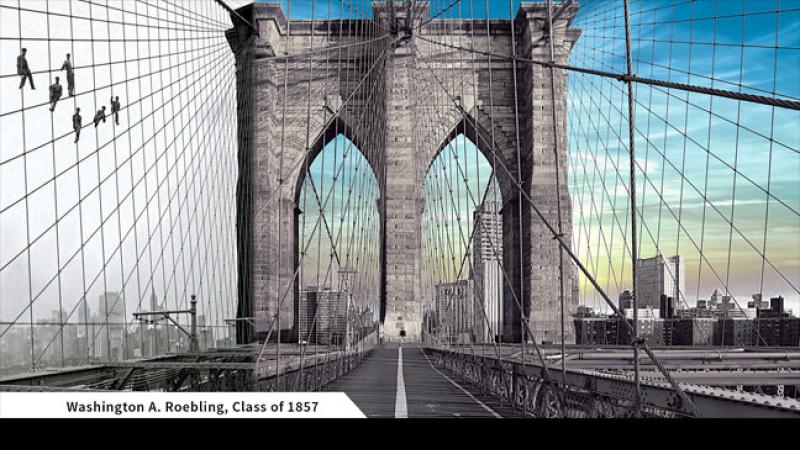Washington Roebling graduated from Rensselaer in 1857
May 24, 2023

The iconic Brooklyn Bridge was opened to the public 140 years ago, on May 24, 1883. Since, millions of vehicles, pedestrians, and cyclists have crossed the Brooklyn Bridge as they travel into Lower Manhattan.
This incredible feat of engineering was made possible by chief engineer Washington Roebling, who graduated from Rensselaer Polytechnic Institute in 1857. The Brooklyn Bridge was the first of 15 bridges in the New York City area that Rensselaer alumni designed, built, or collaborated on. While a major commerce hub, early New York City faced geographical challenges as its five boroughs were separated by water. Rensselaer alumni also worked on the Williamsburg, Manhattan, Tappan Zee, Throgs Neck bridges, among others.
Following distinguished service in the Civil War, Washington Roebling returned to his profession of civil engineering with the firm of his father, John Roebling. Having studied the principles of caisson foundations in Europe, he prepared the detailed plans and specifications for the Brooklyn Bridge. When John Roebling died, Washington succeeded him as chief engineer of the great bridge, the longest suspension bridge in the world at that time.
After he was afflicted with the “bends,” his wife, Emily, stepped in as his unofficial aide-de-camp. She carried out all written communication and face-to-face interviews with contractors with a thorough grasp of engineering. Among the first women leaders in the management of technology, Emily earned a law degree and championed women’s suffrage.
In total, six members of the Rensselaer Alumni Hall of Fame have been inducted for their work as bridge builders. Today, Rensselaer continues its legacy of bridge-building, many times in a metaphorical way. Most recently, the Center for Engineering and Precision Medicine (CEPM) was established in partnership with the Icahn School of Medicine at Mount Sinai. The New York City-based center is bridging engineering and engineering science with medicine to tackle cancer, Alzheimer’s disease, infectious diseases, tissue degeneration, and more. Previously, Rensselaer established the Institute for Energy, the Built Environment, and Smart Systems (EBESS) in partnership with Siemens, Lutron Electronics, the Brooklyn Law School, the building engineering consulting firm Thornton Tomasetti, and the international architecture firms HKS, OBMI, and Perkins&Will. Based in New York City, EBESS is tackling climate change by re-envisioning and designing integrated building environments for human well-being and sustainability. Rensselaer’s Center for Architecture, Science and Ecology (CASE) drives innovation in architecture and the built environment through a unique collaboration among academic faculty and students, research teams, and professional firms.